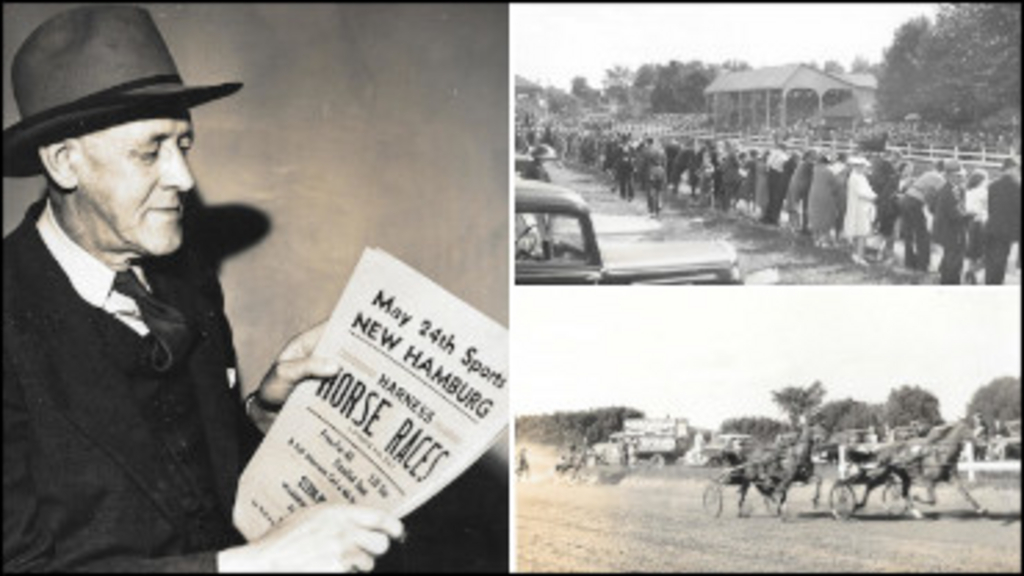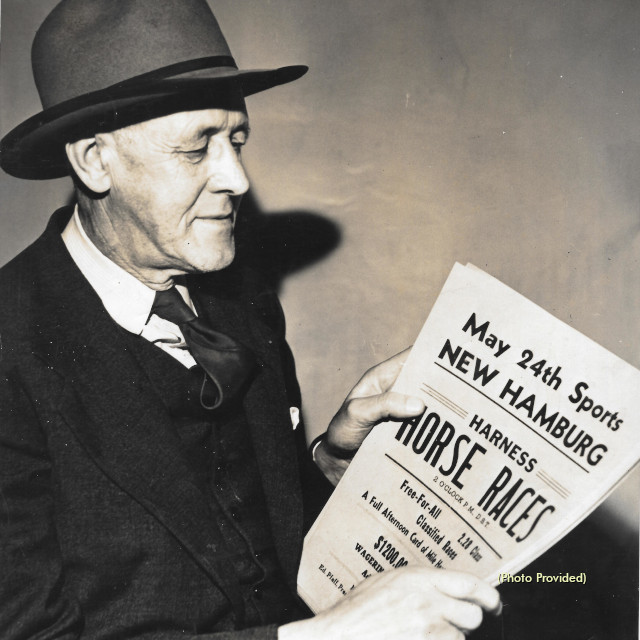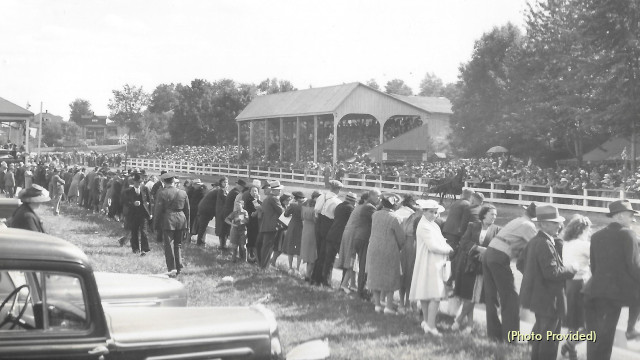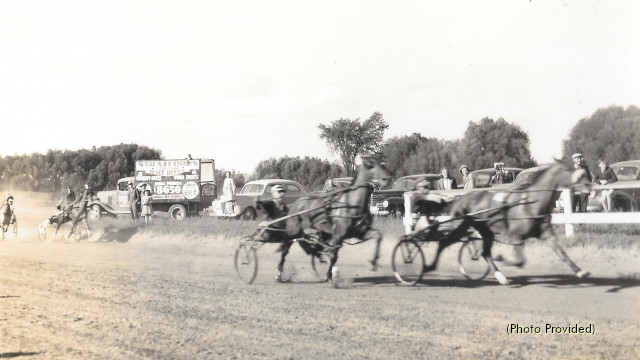
 One of the longest running stakes races in Canadian harness racing, the Canadian Pacing Derby boasts a long and illustrious history from its origins in a small southwestern Ontario town.
One of the longest running stakes races in Canadian harness racing, the Canadian Pacing Derby boasts a long and illustrious history from its origins in a small southwestern Ontario town.
The 2021 edition of Our Heritage Our Home, an annual publication produced by editor and publisher Paul Knowles, carried a feature on the man behind the Canadian Pacing Derby — Earl "Katzie" Katzenmeier penned by Kristen Hahn.
Wilmot Township also produced a video retrospective on the first Canadian Pacing Derby, held some 85 years ago on August 12, 1936 at Fountain Park in New Hamburg, Ont.
Earl Katzenmeier and the Canadian Pacing Derby
At the southernmost end of Jacob Street sits a vast, low-lying area of about 17 acres. The land was originally owned by Absalom Shade in 1837. Following the death of Josiah Cushman from the 1834 cholera outbreak, Shade acquired his holdings at auction for £75 in addition to the £603 he already had invested in this nascent community. His land encompassed all of what became Peel, Jacob, and Bleams Street, and extended as far west as Grandview Avenue. For all intents and purposes, all of downtown New Hamburg was built on land owned by Shade.
He sold it to developer William Scott and donated the flood-prone area for parkland. It became a driving park for people who wanted to exercise their horses. Naturally, this gave rise to racing, and improvements were made in 1894 with the construction of a half-mile track.
A grandstand was built, officially opening on Labour Day, 1911. In 1913 a 200-foot-deep artesian well was dug nearby. It generated enough pressure that a fountain was subsequently built as an extension from the well. The water was high in sulphur and had a strong metallic taste, but people drank it, nevertheless. By 1919 a contest was held to name the park; Eva Erb won with her on-the-nose suggestion: “Fountain Park.”
Fountain Park was further improved upon in 1926 when enough money was raised through subscriptions to build a swimming pool. The well that supplied the fountain also continuously filled the pool, with the overflow draining into the Nith. By this time, New Hamburg was enjoying a tourist boom, with people driving out from Kitchener to camp for the weekend. Trees were planted, picnic tables installed, and kitchen facilities were added to the small log cabin which still stands today.
A fire tore through the grandstand on August 19, 1923, destroying it completely in about ten minutes. It was rebuilt, but interest in harness racing waned in the 1930s as the privations and stresses of the Depression gripped the nation.

Enter Earl “Katzie” Katzenmeier. He was the son of former mayor John Frederick Katzenmeier, a merchant and agent of Massey-Harris farm implements. He learned a lot from his father — perseverance, persuasiveness, and charm foremost among his teachings. Earl was a gifted salesman for Mutual Life Insurance and on June 5, 1936, joined the newly organized Turf Club as the secretary. With him was Dr. Thomas C. Kirkpatrick, president; Lloyd Appel, vice-president; Fred Debus, treasurer; and committee members Ed Pfaff, Robert C. Puddicombe, and Floyd Milton. But it was Katzie who would come to be known as “Mr. Derby.”
Lean, bald, and perpetually dressed in a felt fedora and trench coat, Katzie was a tireless promoter of harness racing in New Hamburg. He spoke at racing meets, handed out handbills, and went door to door soliciting support. Whenever the opportunity presented itself, he would size the mic and tout “the best half-mile track in the country.” He had no problem calling up reporters and exalting the entertainment to be had with the Derby Days. As one journalist said, “When he talked, you listened.”
On August 12, 1936, the first Canadian Pacing Derby was held, marking the start of an annual event that ran until 1957. Eight horses were entered to compete for a purse of $1,275, and over 7,000 spectators were in attendance. There was a bit of fudging on that inaugural event. Alex Parsons, an innkeeper from London, Ontario, was responsible for talking Katzie into starting the derby. “All we did was guarantee him eight horses. For that first race, in 1936, I had to put in four of my own horses at the last minute to make up eight. Then I was wishing we hadn’t been so generous making the entry fee $100.”
The following year, 12,000 people were in the crowd, in addition to a film crew from the Associated Screen News. Coverage of the derby went out across Canada as a “talkie.” The year after it was larger still. After gas rationing of World War II ended, a record 20,000 people jammed into Fountain Park. For a short while, the village of New Hamburg was “a city for a day”. Desperate for more room, the grandstand was demolished and rebuilt in 1947.

The most famous pacer to ever stride across the finish line was a strawberry roan gelding called The Count B. He was owned by New Liskeard resident Jim Brown, and driven first by Tillsonburg’s Clifford “Chappy” Chapman, then his son John. Over his ten-year career The Count B raced 203 times, won 95 heats, finished second 32 times, and third 24 times; earning close to $24,000. His greatest accomplishment was to win the Canadian Pacing Derby in New Hamburg four times in 1944, 1945, 1947, and 1948. In the final heat of the 1948 event he broke a bone in his front leg, and while he did again race in 1951, he was not the same.
In the spring of 1952, The Count B was in Listowel training for an upcoming race. After a routine morning workout, he returned to his stable where he collapsed of a heart attack at 12 years old. His remains were conveyed to New Hamburg where he was buried in the infield, just past the finish line; a granite stone marks the place where, in addition to his name and accolades, is marked his fastest mile: 2 minutes, 6 & 3/5ths of a second.

In some ways, the Canadian Pacing Derby was a victim of its own success. The tireless efforts of Earl Katzenmeier rejuvenated interest in the sport to such an extent that New Hamburg could no longer compete — through purse or track — with better facilities like Woodbine. The 1957 meet, which coincided with the town’s Centennial, attracted only four starters. At the end of the event, Katzie turned to his friends and said, “Gentlemen, you have just witnessed the last Derby.” He retired, and the Turf Club eventually disbanded.
On April 11, 1963, Katzie passed away and was laid to rest at Riverside Cemetery with an honour guard of government representatives, and the hundreds of friends and supporters he had made over his 81 years on earth.
The 1947 grandstand was razed by a devastating fire in 2007 but it was rebuilt with space provided for murals depicting some important historical and current events associated with this property. Prominent among them is a mural that captures the spirit of the Derby Days. Tracy Loch, curator of Castle Kilbride, strove for authenticity when she headed the mural project.
“I contacted the Horse Racing Hall of Fame at Woodbine to help me with the details needed to properly and articulately create this mural. They helped me with the driver’s uniform and described what the artist needed to properly showcase The Count B’s colour as ‘strawberry roan.’ Lance Russwurm, the muralist, captured it perfectly! I loved bringing this back to life on the grandstand with the support of Heritage Wilmot.”
The springs and pools of Fountain Park are long gone – demolished and capped when the current arena was built in 1950. In 1980 the park was renamed Norm S. Hill Park in commemoration of a popular school principal. The half-mile track remains, but today it is used mostly for exercise, having no further purpose for the MCC Quilt Auction, Moparfest, or the Fall Fair.
And yet...perhaps on those fine hot August days, when the cicadas buzz and the sky is a high-vaulted blue, as you aim for your 10,000th step, look around and imagine the infield packed with sleek, chrome-detailed cars; the glittering spray of the fountain; a pool full of rowdy children; the smell of hotdogs and popcorn. Imagine a grandstand heaving with cheering spectators, a megaphone crackling with indecipherable excitement, jubilant blasts from the 20-piece New Hamburg Band, and the thunder of hooves entering the homestretch. Imagine what an awesome spectacle that would have been.
(Article and photos reprinted courtesy Our Heritage Our Home)

